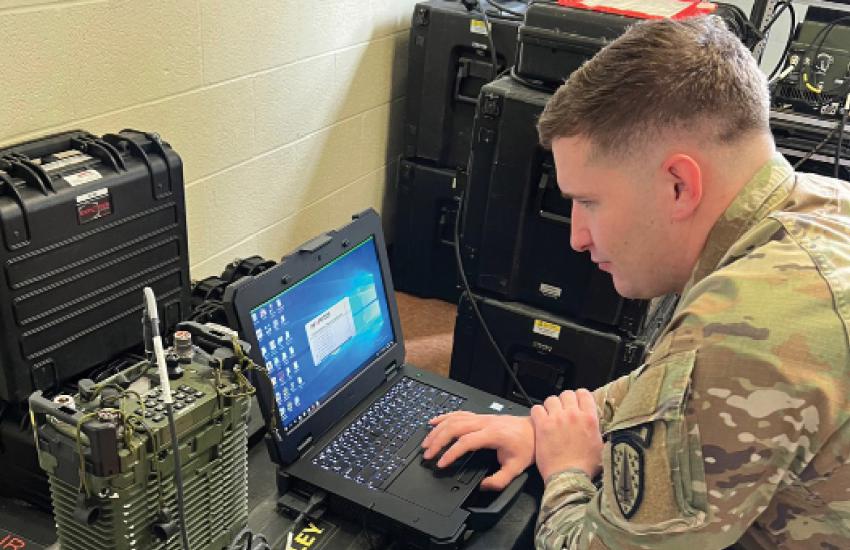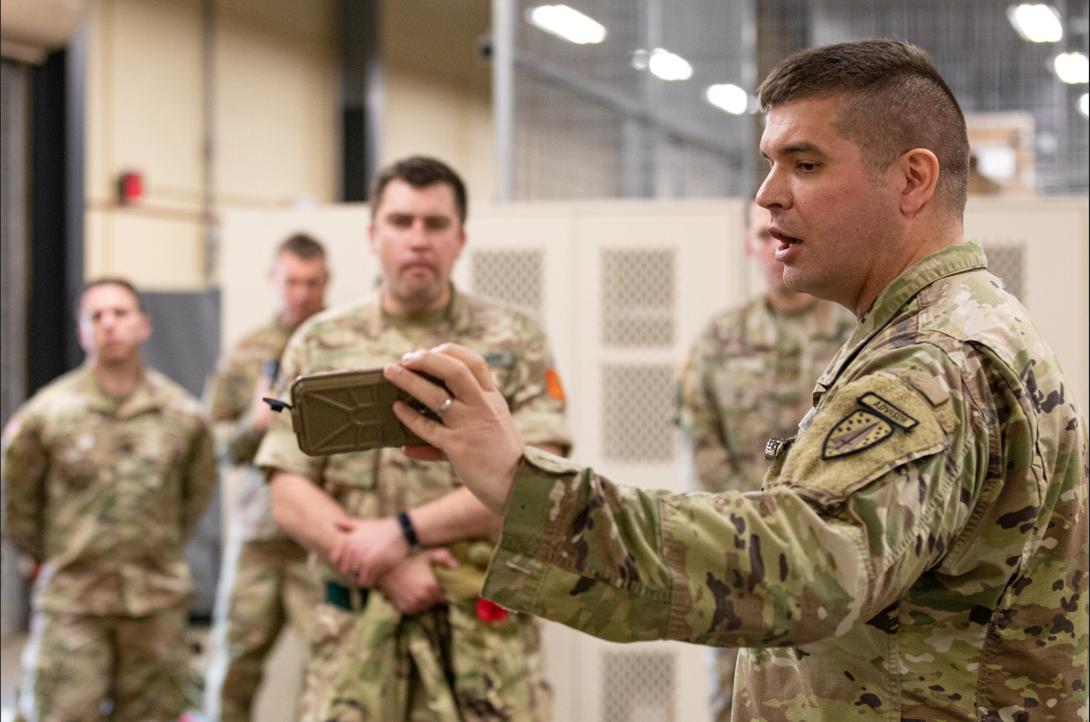Security Force Assistance Command Blazes Army Networks Trails
Implementing a data-centric and unified network involves more than technology upgrades; it also requires personnel and organizational changes. These are some of the lessons the Army’s Security Force Assistance Command (SFAC) is learning, as it solves networking challenges for each of the Army’s six far-flung Security Force Assistance Brigades (SFAB).
Establishing secure and dependable communications between various dissimilar military units is a big part of SFAC’s mission to organize, recruit, staff, train and equip these brigades. SFABs are deployed worldwide to advise, support, liaise with and assess partner forces. This puts a premium on providing assured communications between the brigades and foreign units, which often speak a different language and have different equipment, training and organizational structures.
SFAC is one of the few conventional organizations with a sustained presence in each overseas geographic combatant command and is required to integrate into the Army’s Enterprise Network. SFAC’s experience in enabling communications for SFABs can help with the development of the Army’s Unified Network.
“SFAC is on the leading edge of integrating data and communications capabilities into a system-of-systems within the Army’s unified network,” said Brig. Gen. Marne Sutten, G6 for U.S. Army Forces Command (FORSCOM).
The unified network will enable the sharing and use of data within the Army and between the Army and other organizations, such as the Air Force, Navy, Marines and Coast Guard, as well as allied or partner military forces. This network is considered a key component as the Army modernizes to conduct multidomain operations on land, water, air, space and cyberspace.
SFAC has developed and deployed a global and flat unified network architecture. It uses central hubs linked to servers, workstations and other peripheral devices to minimize the use of routers. This flexible and non-hierarchal design provides SFABs rapid access to data at the tactical edge. This enables rapid decision-making for commanders from anywhere in the world.
This one-hop network architecture simultaneously provides services to forces inside and outside of the continental United States, reduces network latency and increases unit operational readiness by enabling a “fight tonight” capability. A “one-hop” network uses hub stations to communicate with the terminals to minimize the number of times a transmission has to travel to and from a satellite. This reduces the delay, or latency, that takes place when signals travel all the way out to space and then back to Earth. Latency is a frequent cause of errors or data transmission problems in networks.
SFAC utilizes the Army’s existing network architecture and the Global Agile Integrated Transport design to connect into any worldwide regional hub nodes or through commercial landing sites, which route the information to SFAC mission enclaves hosted within sanctuary at home station regional hub nodes.
To ensure fast and reliable access to this data, SFAC is employing cutting-edge technology to integrate new system architectures using multiple communications methods to transmit data and information. SFAC can keep pace with evolving technology within the Integrated Tactical Network (ITN) by leveraging multiple commercial-off-the-shelf items. As the ITN has matured from initial fielding, SFAC has coordinated with program managers and developers to evaluate emerging technologies on their integration capability within ITN, including a mix of military and commercial wired, wireless and satellite communication systems.
SFAC’s approach is “transport agnostic,” so communication will not depend upon using a particular mode or “path” for transmissions. Aligned with the Army’s vision for the future network, the transport-agnostic approach increases network survivability in congested and contested environments by providing units multiple alternate transport paths if enemy action or other circumstances interfere with data and communications access.
“This is more complicated than it seems,” said CW3 Abe Menendez, SFAC senior information services technician. “When advisors have to pick a path for transporting their data, a lot of problems can arise from latency, or the time it takes for a signal to travel from the sender to the receiver. It is about ensuring that our soldiers and commanders have assured access to data at the tactical edge.”
Another challenge is that the Army’s backend network is not postured to support heavy usage from commercial capabilities since the network is at the mercy of its slowest or most constricted links.
This is an important issue because the Army’s SFABs operate in far-flung regions, usually outside of traditional military satellite and Joint Battle Command-Platform coverage areas. SFABs adapt by utilizing a mixture of military and commercial transport systems to enable connectivity.
By using satellite-as-a-managed-service—which the Army plans to pilot in late 2023—the service seeks the ability to access commercial satellite network resources on demand anywhere in the world when needed.
“SFAC’s efforts are helping to show the Army a way forward to upgrade or increase throughput by using commercial circuits to support future, high-bandwidth network capabilities,” said Maj. Gen. Jeth Rey, director of Army Futures Command’s Network Cross Functional Team.

Other technical solutions to enable unified network operations are also being assessed. In February, SFAC integrated a system called a performance-enhancing proxy within the cloud architecture, which automatically adjusts timing or latency of signals coming from different sources to eliminate network latency issues between military satellite and commercial satellite connections.
SFAC is also evaluating a hardware-based system that can connect up to eight wide area network-enabled devices simultaneously, providing automatic primary, alternate, contingency and emergency communications options. These systems blend different types of network transport systems into one large bandwidth pipe, providing commanders access to more data while providing automatic failover between transport systems.
“It is important to maintain diversity of transport through different pathways across multiple spectrums,” said Sgt. First Class Dave Jackson, SFAC G6 modernization and training noncommissioned officer. These different pathways can include different satellite orbits, such as low Earth, medium Earth, Polar and geosynchronous orbits, as well as a variety of terrestrial transport pathways, including fiber optic, cable and microwave, he said. Also available are beyond-line-of-sight pathways that transmit using a variety of modulation methods, as well as different frequencies and waveforms.
Organization is also important to building a flexible, resilient communications network, said Maj. Gen. Donn Hill, SFAC commanding general.
SFABs are primarily comprised of small advisor teams of four to 12 personnel. The nature of these small teams requires a high degree of trust, and the key to trust is having highly trained and disciplined teams. The SFAC mantra of “one captain, one team, one country” emphasizes this trust across the command. These SFABs must work closely with a wide variety of American and foreign organizations.
“Maintaining dependable communications worldwide for the SFABs is difficult, especially between different organizations using different radios, common operating pictures and networks,” said Gen. Hill. “But while technology can help overcome connectivity problems, we are learning that organizational changes, modified operating procedures and investments in personnel are just as important for enabling and defending a resilient, secure unified Army network.”
Organizational changes include where units place important system components. To ensure network survivability, SFAB disperses and relocates key elements of its communications network. Smaller servers are located close to the edge of battle to reduce latency and speed up information technology operations. SFABs utilize multiple transport-agnostic systems to route data from the tactical edge.
Other modifications involve personnel and organizational procedures. Who can make a call for fire? Who then allocates assets to engage with the enemy? Whose approval is necessary to make changes in network operations?
For example, SFAC standardized communications and data operations of the SFABs and built brigade-level signal and information technology teams with the authority to control external and internal connections. SFABs are empowered and trusted to make necessary changes on the network because of their training. SFAC created the program of instruction for the Army’s ITN Operators Course, located on Fort Bragg, North Carolina, which provides training and certification on the operation of all ITN systems. This effort, combined with monthly division-level communication exercises, produces communicators who are experts in their craft.
Other organizational decisions still must be made, such as what kind of information will be shared and with whom it will be shared. For example, battlefield operations require knowing where your fellow units are operating. SFAC has enhanced this capability for all U.S., or “blue” forces, that use the blue common operating picture in each geographic combatant command. In coordination with Army program managers, the SFAC developed solutions that link the ITN common operating picture with the Army’s secret common operating pictures. This enables ITN units to see non-ITN units on their equipment and vice versa.
Emphasizing that the soldier is the key to success, Gen. Rey said: “In concert with these personnel and organizational modifications, we need highly trained communicators to implement data-centricity and provide the warfighter unsurpassed technological superiority against the enemy in future fights. By integrating emerging technologies and concepts today, we are well on our way to delivering the Army’s network for 2030.”
Lt. Col. Joe Kaminski, USA, is a Signal Corps officer serving as the Security Force Assistance Command G6 at Ft. Bragg, North Carolina. In his 19 years of service, he has served in multiple combat and operational deployments and has trained/advised/assisted missions providing strategic NATO communication knowledge and expertise, enhancing ally and partner communication capabilities.
The opinions expressed in this article are not to be construed as official or reflecting the views of AFCEA International.






Comments